|
Search
this site

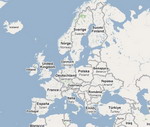
View
map of Europe
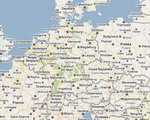
View
map of Germany

|
 |



| GERMANY
TRAVEL INFORMATION |
|

|
Travel
To Germany: The Pulse Of European History by Frank Johnson
Germany has long been a mover
and shaker of European history, creating waves in time for the rest of
the continent to ride out. From Charlemagne and Otto von Bismarck to Nazism
and the Cold War, Germany has become the epicenter of cutting-edge culture
and music, and centuries of tradition and fine arts. The juxtaposition
of medieval towns against ultra-modern industrialism is a fascinating reality
to experience.
Thriving Urban Centers
of Germany
The capital city of Berlin
is by far the most dynamic and diverse metropolis for the German traveler.
Despite reunification projects since the Wall came down in 1989, the city
is still very much divided between the cosmopolitan chic of the West and
the tattered Communist remains of the East. The Stasi Museum, located in
East Berlin, is home to the former State Security Service. The intelligence
body spied on and badgered citizens throughout the Communist era from this
building. The Brandenburger Tor is a monumental building built in 1792
as one of the city's 14 gates. The history of this landmark is tied directly
with the enclosing of West Germany from the East as it was essentially
barricaded in by the Berlin Wall.
In addition to the other
popular urban destinations of Munich
and Frankfurt, Aachen
(also known as Aix-la-Chapelle) should not be missed on a German visit.
It is considered the most international of cities in Germany, situated
close to the Belgian and Netherlands borders. Many citizens and travelers
enjoy regular access to both border nations. The main draw is the Aachen
Dom (Aachen Cathedral), which is the oldest landmark in Germany. Emperor
Charlemagne had the chapel constructed over 1200 years ago and Holy Roman
Emperors were coroneted here for nearly 600 years. The cathedral is also
alleged to possess Christ's loincloth as part of its collection.


Buy
at AllPosters.com
|
Fables and Fairytales
The German landscape is still
comparable to your favorite fairytale or Robin Hood adventure. Castles
in the sky preside over the rich green forests where Hansel and Gretel
ventured to meet their witch. The
Black Forest (Schwarzwald) is famous for its intense evergreen canopy,
vast outdoor activities and secluded get-aways. It also happens to be where
Nobel Prize winner Hermann Hesse spent much of his life living and writing.
The Maulbronn monastery, situated in the forest's north end, is a UNESCO
World Heritage sight that has been carefully preserved. The entire wooded
expanse is dotted with medieval and farm towns and is fairly easy to navigate
by train.
The notorious 19th century
Bavarian king, Ludwig II (Ludwig Friedrich Wilhelm), left his personal
legend all over the German countryside in the form of extravagantly ornate
castles. Schloss Neuschwanstein is Ludwig's (and Germany's) most famous
construction, particularly because he contracted a stage designer rather
than an architect to do the job. Although the monstrosity was never actually
finished, visitors may enjoy concerts in the castle's centerpiece, Minstrel's
Hall, every September. |

Along Germany's southwest
border, The Rhine Valley stretches as a monument to the country's timeless
culture and love affair with art, wine, food and beer. The Middle Rhine
Valley (also a World Heritage sight) is the most popular segment, studded
with medieval and gothic towns and wineries that hold their own festivals
annually. Additionally, WWII has left its distinct mark throughout the
region despite the incredible restoration efforts undertaken over the years.
Social revolutions, wars
and a fair share of domestic turmoil combined with the legacy of the Holy
Roman Empire and the split of the Protestant Church all make Germany unmistakably
unique and internationally modern. Travel Germany and discover that it's
not all about the Beer Gardens!
top
|
| About the Author -
Discount
Airfare to Germany |
 |
| I
Love German Wine and Food - A Mosel Qualitaetswein by Levi
Reiss
If you are in the mood for
some fine German wine and food, you should really consider the Mosel region
of central western Germany on the border of Luxembourg.
You may even find a bargain, and I hope that you'll have fun on this fact-filled
wine education tour in which we review a local white Qualitaetswein (read
inexpensive) Riesling.
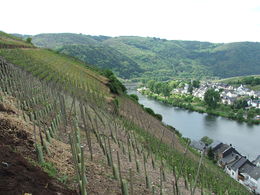 The
Mosel Valley is felt to be one of the most beautiful river valleys in the
world. This region, previously called Mosel-Saar-Ruwer in honor of its
three rivers, is famous for its Riesling wine. Some of the greatest Rieslings
in Germany and in fact in the entire world come from the Mosel Valley.
Experts can often identify Mosel Rieslings because of the slate in the
local soil, which may impart a taste of flint. The slopes are among the
steepest in the wine-producing world, and sometimes attain 70 degrees.
The soil is so precious that every spring local workers lug pails of soil
up these steep slopes, temporarily reversing the effect of the rains that
wash the soil down every winter. The
Mosel Valley is felt to be one of the most beautiful river valleys in the
world. This region, previously called Mosel-Saar-Ruwer in honor of its
three rivers, is famous for its Riesling wine. Some of the greatest Rieslings
in Germany and in fact in the entire world come from the Mosel Valley.
Experts can often identify Mosel Rieslings because of the slate in the
local soil, which may impart a taste of flint. The slopes are among the
steepest in the wine-producing world, and sometimes attain 70 degrees.
The soil is so precious that every spring local workers lug pails of soil
up these steep slopes, temporarily reversing the effect of the rains that
wash the soil down every winter.
Mosel ranks number five among
the thirteen German wine regions when it comes to both vineyard acreage
and total wine production. Slightly over three quarters of the regional
wine is classified as QbA and somewhat less than one quarter is higher
quality QmP wine. Only one percent is table wine. Over half of Mosel wine
is Riesling. The German hybrid white grape variety Mueller-Thurgau represents
about 20% of the wine production. In third place is the historic Elbing
that dates back to Roman times. Only about 2% of Mosel wine is red.
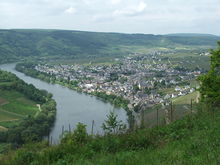 The
Mosel Valley pretty well stretches from Koblenz which isn't far from Germany's
former capital Bonn to the city of
Trier sitting very close to the border with Luxembourg.
These two fine cities are linked by the Mosel Weinstrasse (Mosel Wine Road)
which is approximately 140 miles (224 kilometers) long on the eastern side
of the river and somewhat less on the western side. Of course, you could
take the autobahn to travel between Koblenz and Trier at breakneck speed.
If you do, you'll miss the interesting little towns and vineyards along
the way. The
Mosel Valley pretty well stretches from Koblenz which isn't far from Germany's
former capital Bonn to the city of
Trier sitting very close to the border with Luxembourg.
These two fine cities are linked by the Mosel Weinstrasse (Mosel Wine Road)
which is approximately 140 miles (224 kilometers) long on the eastern side
of the river and somewhat less on the western side. Of course, you could
take the autobahn to travel between Koblenz and Trier at breakneck speed.
If you do, you'll miss the interesting little towns and vineyards along
the way.
Cochem lies about one third
of the way from Koblenz to Trier. It's a fine little Mosel River Valley
town. This medieval town is long and narrow. You should take a boat trip
as well as a walking tour. Outside the town gate is the Kaiser Wilhelm
railway tunnel, which at 2.5 miles (4 kilometers) is the longest in all
Germany. About fifteen minutes of walking get you to the Reichsburg (Imperial
Fortress), a thousand year old castle that overlooks Cochem. The castle
hosts a medieval banquet which features period costumes and music on Fridays
and Saturdays but you must reserve in advance. North of the city is a larger
castle, the Burg Eltz a few miles inland from the Mosel.
Before reviewing the Mosel
wine and imported cheeses that we were lucky enough to purchase at a local
wine store and a local Italian food store, here are a few suggestions of
what to eat with indigenous wines when touring this beautiful region. Start
with Aalsuppe (Eel Soup). For your second course enjoy Rolladen (Beef rolls
with Bacon and Pickles). As a dessert indulge yourself with Moselweintorte
(Chocolate and Wine Cake).
OUR WINE REVIEW POLICY
All wines that we taste and review are purchased at the full retail price.
Wine Reviewed Moselland Bernkasteler
Kurfurstlay 2005 9.5% alcohol about $8.50
Let's start by quoting the
marketing materials. Tasting Note: Pale straw yellow colour; citrus, mineral
and dried apricot aromas and flavours; balanced with crisp acidity in the
finish. Serving Suggestion: Serve chilled with pork, turkey or appetizers.
Spicy asian dishes.
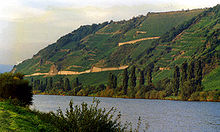 My
first pairing was with a homemade pizza with lots of tomato sauce, vegetables,
and cheese but no meat. This wine displayed refreshing acidity that worked
well with the pizza sauce. It had good fruit and was surprisingly long. My
first pairing was with a homemade pizza with lots of tomato sauce, vegetables,
and cheese but no meat. This wine displayed refreshing acidity that worked
well with the pizza sauce. It had good fruit and was surprisingly long.
The next meal included a
barbecued chicken marinated in a commercial Mediterranean-style light sauce,
red-skinned potatoes, and a somewhat spicy Turkish salad. The wine's acidity
cut the fat very well and yet complemented the tomato's own acidity which
largely defined the salad. This little and lightly alcoholic wine (9.5%
when 13% plus seems to be the new norm) was quite assertive, especially
with the potatoes. And yet it was somewhat flat with dessert, some orange
fruit-juice candy.
The final meal was whole-wheat
pasta in a sauce that started our as your basic commercial pasta sauce
and then livened up by a fried medley of garlic, red onions, red and green
peppers, topped with anchovies and shredded (local) Asiago cheese. The
wine was light and fruity and the combination was quite tasty. I was happy
that this Riesling was low-alcohol (and inexpensive) so that I could drink
quite a bit without any negative effects, including to my pocketbook.
The initial cheese pairing
was with a mild Italian Pecorino Fruilano. The wine was sweet but didn't
impress me very much. Then I paired it with a nutty Dutch Edam cheese.
Once again the wine was sweet but it was round and the combination went
quite well.
Final verdict. Great bargain.
The wine really goes well with simple food. I didn't get a chance to try
it with gourmet specialties but wouldn't be surprised if it did as well
as many wines including Rieslings at twice the price. If I weren't saddled
with so many wines to taste (talk about problems) I'd buy half a case and
drink one every two months or so. Then I'd try one from the next vintage
and hope to repeat the process.
top
|
| About the Author - Once
upon a time Levi Reiss wrote ten computer and Internet books either alone
or with a co-author. And yet, he really prefers drinking fine Italian or
other wine, with the right food and friends. He knows about dieting but
now eats and drinks what he wants, in moderation. He teaches computers
at an Ontario French-language community college. Visit his Italian travel
website http://www.travelitalytravel.com
which focuses on local wine and food. |
 |
| Interesting
Facts About Germany by Milo Jarvis
Germany has always held a
reputation of being a rich and progressive nation. Contributing much in
terms of human progress and industrial/financial revolution. Germany has
given birth to many people and ideologies that have helped to shape the
world as we know it.
The official name of Germany
is The Federal Republic of Germany. It is located in West Europe. The Baltic
Sea, North Sea, and Denmark
surround Germany on the north. It is flanked on the east by the Czech
Republic and Poland. Flanked on the west by
France,
Belgium,
and
Luxembourg
and Netherlands.
The southern borders are Austria
and Switzerland.
Germany is a member of the
European Union (EU). Germany has Europe's largest economy and is Europe's
second largest populous nation. The total area of Germany is 357,021 sq.
km. The total land area is 349,223 sq. km. The total covered by water being
7,798 sq. km. The capital of The Federal Republic of Germany is Berlin.
Other major cities are Munich,
Hanover,
Stuttgart,
Hamburg,
Dusseldorf,
Cologne,
and Bremen. Germany is a federal
republic with a parliamentary democracy.
The ethnicity of Germany's
population is 91.5% German, 2.4% Turkish, 6.1% others such as Greeks, Italians,
Polish, Russians, Serb-Croatians, Spanish. The main religions in Germany
are Protestant (Evangelisch) 38%, Roman Catholic (Katholisch) 34%, Muslim
1.7%, and others make up 26.3%. Classical music has been dominated by German
speaking composers. A few of the famous ones born on German ground include
Beethoven, Schumann, Bach, Brahms, Handel, Mendelssohn, Wagner and R. Strauss.
Some of the worlds wisest philosophers were German: Nietzsche, Kant, Hegel,
Schopenhauer, and Heidegger.

| Germany boasts around 700
zoological gardens, aquariums, bird parks, wildlife parks, animal reserves,
or safari parks, not to mention 414 registered zoos. Berlin's Zoologischer
Garten is the world's largest zoo, number of species (1,500) and animal
population (14,000). The Fairy Grottoes (Feengrotten) in Saalfeld, Thuringia,
are the world's most colorful caves, according to the Guinness Book of
Records.
Since 2003, Germany is the
world's largest exporter of goods with $1.016 trillion exported in 2005.
10.1% of the world's exports come from Germany. Germany is the worlds second
largest producer of cars (after Japan) and motor
vehicle in general(after the United States). The German based company BASF
(Badische Anilin- und Soda- Fabrik) is the second largest chemical company
in the world, employing about 87,000 people in 160 subsidiaries and joint
ventures in 41 countries. |

Buy
at AllPosters.com
|

The biggest train station
in Europe is located in Berlin.
The European Central Bank is in Frankfurt-am-Main,
Germany. Frankfurt International Airport claims the world record in the
most international destinations served. The Lufthansa, based in Frankfurt,
is the worlds largest airline in terms of international passengers carried,
and Europe's largest in terms of passenger-kilometers flown, freight tonne-kilometers
flown and fleet size. The largest department store in continental Europe
is the KaDeWe (Kaufhaus des Westens) in Berlin,
with over 60,000 square meters covered.
top
|
| About the Author - To learn
about German Language Courses or for information about learning to speak
German, please visit my blog Learn to Speak German at http://learnspeakgerman.blogspot.com |
 |
| Top
Ten Places To Visit In Germany by Jonathan Williams
If you're looking for a place
that's rich with remnants of the recent past, then Germany's the place
for you. As you may well know, Germany was a key player in the previous
world wars. Thus, it filled Germany with monuments to the stories of our
grandfathers about times long past but never forgotten.

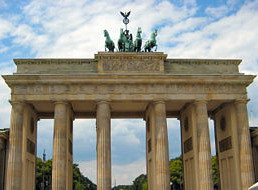
|
1.) Berlin Wall
There's no other place in
Germany that's more suffused with charged up emotions than the Berlin
Wall. You can just imagine the tears and the blood shed over this very
wall. This remnant of the wars stands as one of the greatest monuments
to democracy known to man - a sign that freedom will always come out victorious.
2.) The Romantic Road
Driving through the Romantic
road would be one of the most pleasant drives you'll experience in your
whole life. This road is flanked by scenic landscapes on both sides. |

Occasionally, you'll pass
through a picturesque town, a beautiful gothic church, and sometimes, a
quaint countryside inn.
3.) Augsburg
Passing through the Romantic
Road will lead you to Augsburg,
a town founded by the Roman Legions and named after the esteemed Roman
emperor, Augustus. This picturesque town contains such historical places
as St. Anne's Church, the place where Martin Luther took refuge, and Dom,
a very unusual Cathedral. You can also find here the Renaissance Golden
Room, a sight that will make you squint with its shine.
4.) Neuschwanstein Castle
Did you know that Walt Disney
used a castle found in Germany as his inspiration for the castle of Sleeping
Beauty? It's true, those alabaster walls and those high towers and wide
parapets were all based on the Neuschwanstein Castle. It is now hailed
as one of the most popular tourist spots in Germany.
5.) The Castles of Fussen
Like most of Europe, several
castles are littered throughout Germany. It contains the other two of Ludwig's
castles, the first one being the Neuschwanstein Castle. This is a must-see
for all those families who are traveling through Germany because the place
literally looks like it's been torn out of a storybook.
6.) Lake Constance
Lake Constance is both a
tourist spot and an essential source of life for the Germans. Several areas
in the country rely on this very lake for their drinking water, and this
large lake is also a great place to swim and to go bird watching. Indeed,
if you're one for beautiful natural sceneries, then Lake Constance is not
to be ignored.
7.) The Black Forest
The name looks like it has
been taken from one of the fairytales, doesn't it? The
Black Forest - it sounds like a place where evil witches reside and
cursed trees grow, but don't let that deter you though.

| If anything, the Black Forest
can hardly be related to its name as it's a sunny forest with tall and
sturdy firs. It's a great place to go hiking and a great place for picnics.
8.) Cologne
When you hear the word, Cologne,
what comes into your mind? A beautiful fragrance, right? Well, meet the
town that's called Cologne for a reason, and indeed, the town of Cologne
has its own peculiar fragrance that's very pleasing to the nose. Also,
there you will find a beautiful view of the River Rhine and the Cologne
Cathedral. |

Buy
This Allposters.com
|
9.) Dachau
Take a break from the fairytale
castles and mystical forests and go to the place called Dachau. Dachau
is a concentration camp - a remnant of Germany's dark past where you can
just imagine the horrors that took place in this very spot. However, you
will also find there a statue bearing the inscription, "Never Again", a
solemn promise of the German people that they will 'never again' commit
such unspeakable acts - another true victory for peace.
10.) Oktoberfest
The Oktoberfest - technically,
it's not a place, but it's just too good a festival to leave out of any
'top ten list' that concerns tourism and Germany. This fun-filled festival
in the town of Bavaria is guaranteed to leave you intoxicated and euphoric.
You can spend days on end just drinking authentic German Ale and just letting
yourself loose.
top
|
| About the Author -
Jonathan Williams is the travel writer for Destination Guide TV - the place
to share travel videos. Visit http://www.destinationguide.tv/germany
to view or share Germany travel videos. |

  
 |

